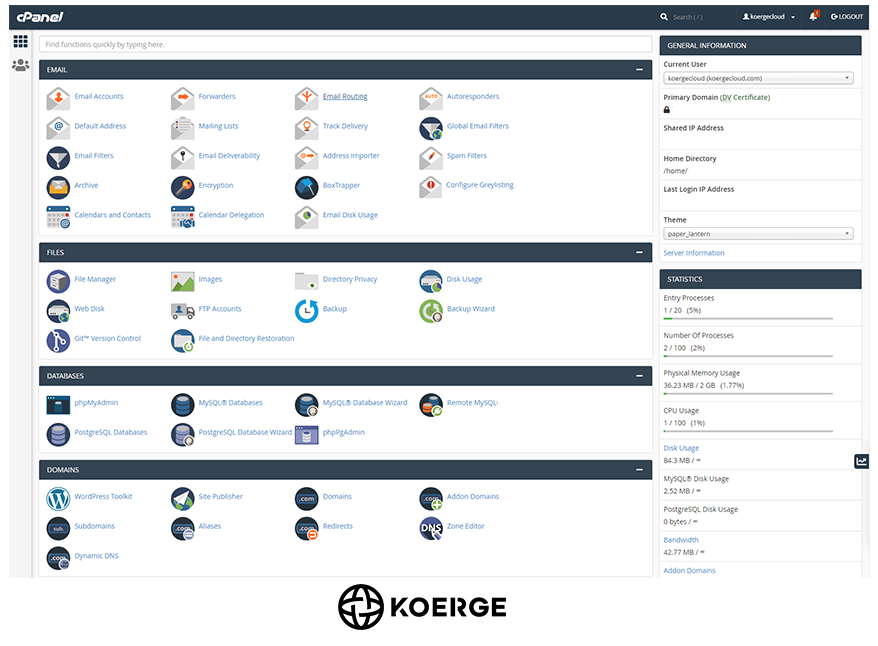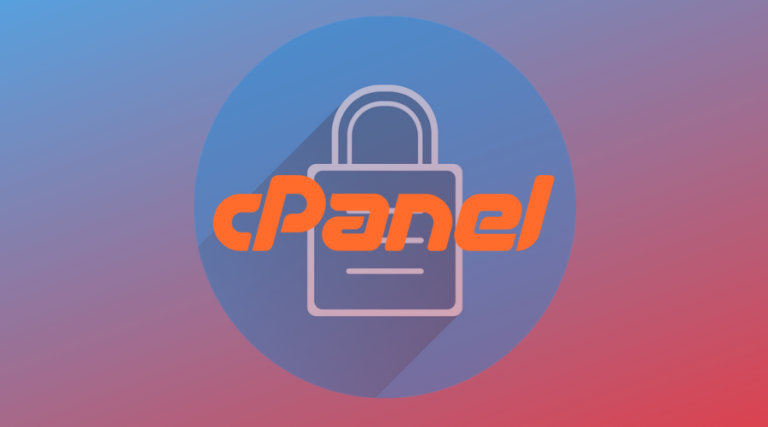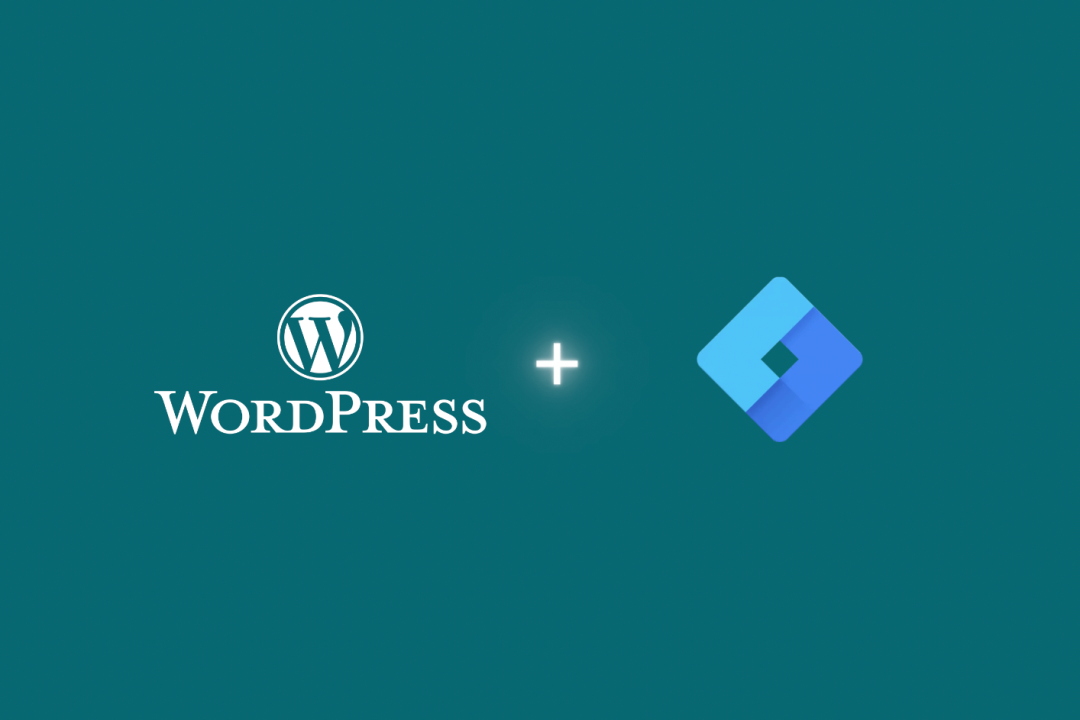
cPanel is a Linux-based graphical interface also known as a GUI, that is used as a control panel to make website and server management easier. cPanel allows users to publish websites, make use of web files, create email accounts manage domains and much more.
cPanel is known as one of the most popular online control panel in the World. It is provided by most web hosting companies to customers as part of a hosting plan. The control panel has 2 interfaces, one is called cPanel and one is used as a server management interface, it is called Web Host Manager (WHM). By having this combination users can manage their website, whilst web hosting providers are provided with a control panel to manage their servers.
Is cPanel Free?
cPanel is not free because it is a third-party application. However, most hosting providers, including Koerge, include cPanel in their hosting plans at no extra cost. There are some providers who will supply cPanel free for the first year, and then charge a fee on subsequent years however Koerge does not charge customers for cPanel.
Is cPanel account Private?
A cPanel account is generally considered to be private, as it is intended for use by the individual or organization that owns the web hosting account. The login credentials for a cPanel account, such as the username and password, should be kept confidential and not shared with others.
However, it’s important to note that the level of privacy and security of a cPanel account can vary depending on the hosting provider and the security measures they have in place. Hosting providers may have different policies and procedures for managing and securing cPanel accounts. It’s a good idea to check with your hosting provider about the security and privacy measures they have in place to protect your cPanel account.
Also, it’s important to ensure that your cPanel account has a strong password, and use two-factor authentication if provided by your hosting provider. Additionally, make sure that you keep your cPanel software and all of the software installed on it updated to the latest version to make sure that you are protected from any known vulnerabilities.

How can I login to cPanel
It’s quite easy to access your cPanel, all you need to do is type in your website address into your browser’s address bar followed by a colon and 2083. For example https://yourdomain.com:2083. Or alternatively, if you are using Koerge web hosting, you can simply login to cPanel by navigating to cpanel.koerge.com
It is also possible to access cPanel by typing in your website domain followed by /cpanel. For example https://yourdomain.com/cpanel
Sometimes when you have only just set up your website you may need to use an IP address to access the cPanel. For example https://10.10.10:2083.
Using the techniques above will take you to the cPanel login screen where you will be able to put in your Username and Password.
Where can I find my cPanel logins?
To get your cPanel username and password, you can do the following:
- Check the email account you used to sign up to Koerge. Many hosting providers will send you an email with your cPanel login details when you first sign up.
- Contact your hosting provider’s customer support team and ask them to provide you with your cPanel login details. If you are using Koerge, contact us here.
- If you have access to your server, you can also check the config file on the server.
- If you have lost your cPanel username and password, you may need to reset it. Most hosting providers will have a “forgot password” option on the login page or you can contact their customer support for assistance with resetting your password.
What does the cPanel dashboard look like?

The cPanel dashboard typically has a graphical user interface (GUI) that is divided into different sections, such as:
- Home: This section provides an overview of your account, including disk space usage and resource usage statistics.
- Mail: This section allows you to manage your email accounts, forwarders, and autoresponders.
- Domains: This section allows you to manage your domains, including adding subdomains, redirecting domains, and managing DNS records.
- Databases: This section allows you to manage your databases, including creating and deleting databases, managing users, and running SQL queries.
- Files: This section allows you to manage your files, including uploading, downloading, and editing files.
- Security: This section allows you to manage security settings, including creating backups, managing SSL certificates, and password-protecting directories.
- Advanced: This section includes advanced features, such as cron jobs, Apache handlers, and error pages.
- Preferences: This section allows you to change your cPanel settings, such as the language, theme and timezone.
Does cPanel support custom email addresses?
Yes, cPanel supports custom email addresses. Through the cPanel Mail section, you can create and manage email accounts associated with your domain name. This allows you to create custom email addresses like “name@yourdomain.com” instead of using generic email addresses provided by a provider.
You can create new email addresses, forwarders, and autoresponders, as well as manage the settings for existing email addresses. You can also set up email filters to automatically sort and forward incoming messages, and access your email through webmail.
Additionally, you can use cPanel’s email client like Horde, Roundcube or SquirrelMail to check your email from a web browser or you can use an external email client like Outlook, Thunderbird or Mail app on your mobile device or computer to configure and access your email using the email account’s settings (IMAP, POP3, SMTP).

Who and when was cPanel founded?
cPanel was founded by John Nick Koston in 1996. He created the first version of cPanel as a control panel for the Red Hat Linux operating system while working as a web hosting provider. cPanel was initially created to make it easier for users to manage their web hosting accounts, and it quickly became popular among web hosting companies and users alike.
Throughout the years, the company continued to develop and improve the cPanel software, adding new features and making it compatible with other operating systems. Today, cPanel is considered one of the most widely used control panels in the web hosting industry and it is being used by many web hosting providers worldwide.






